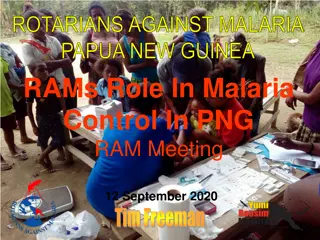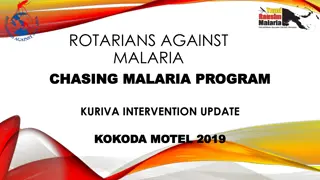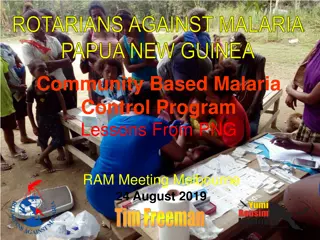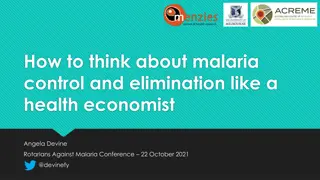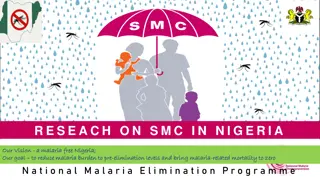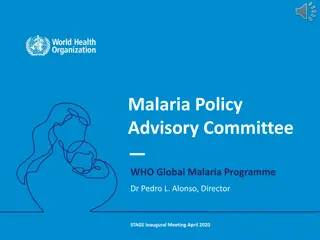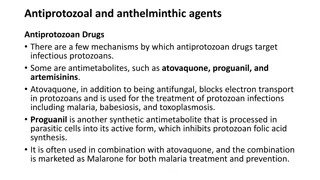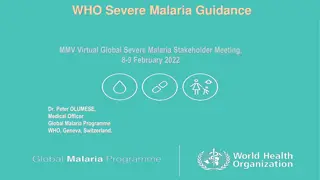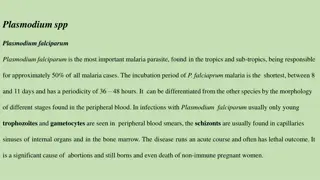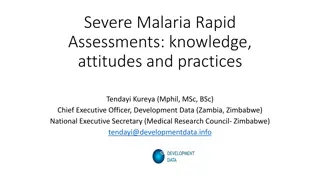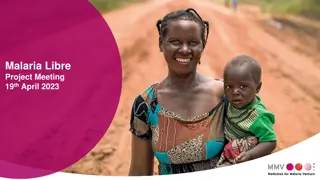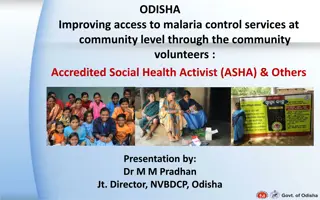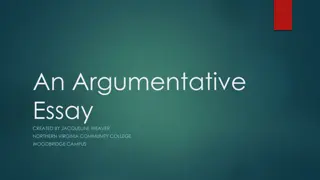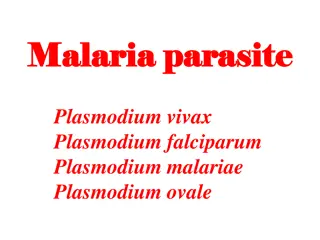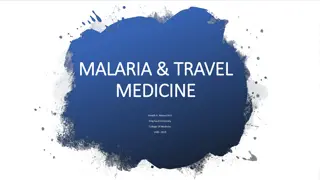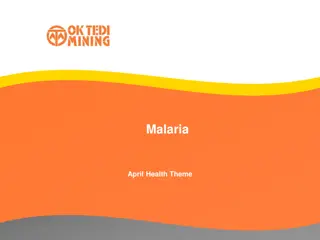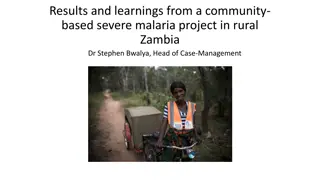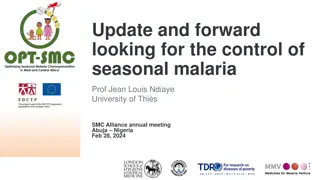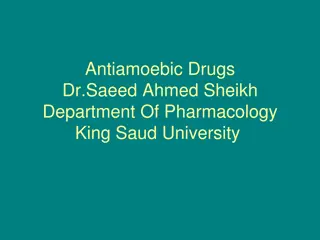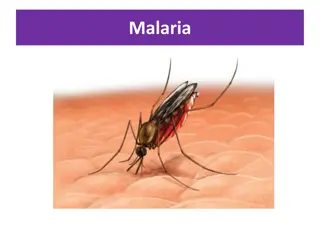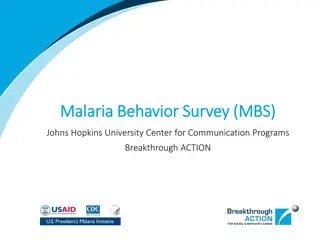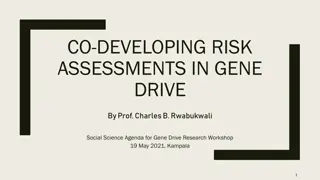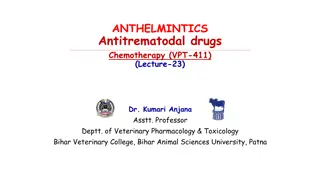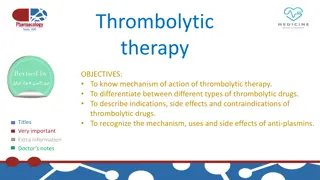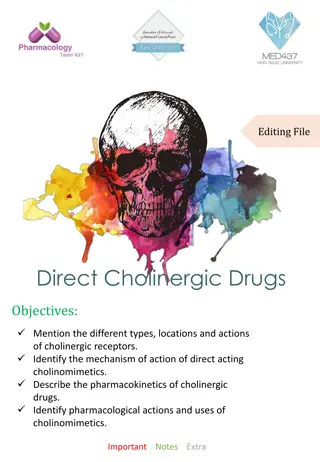Understanding Antimalarial Drugs and Malaria Transmission
Explore the world of antimalarial drugs and the intriguing case of a non-traveler contracting malaria in Italy. Learn about the main antimalarial drugs, WHO therapeutic strategies, and the global impact of malaria. Delve into the complexities of malaria transmission and the potential factors at play, from climate change to healthcare practices.
Download Presentation

Please find below an Image/Link to download the presentation.
The content on the website is provided AS IS for your information and personal use only. It may not be sold, licensed, or shared on other websites without obtaining consent from the author. Download presentation by click this link. If you encounter any issues during the download, it is possible that the publisher has removed the file from their server.
E N D
Presentation Transcript
Antiprotozoal /Antimalarial drugs Antiprotozoal /Antimalarial drugs Dr. Osama Dr. Aliah 1
Mysterious & puzzling case of malaria Sofia Zago died of cerebral malaria after developing a fever & slipping into a coma last September in north Italy Sofia had NOT travelled to any at-risk countries World Health Organization declared Italy free of malaria in 1970 Sofia did NOT have blood transfusion recently
How did sofia contract malaria? Could it be transmitted from immigrants? Malaria is not transmitted from person to person conan Could climate change to blame for the first-home grown case in 50 years ? With global climate change, the potential for the reappearance of malaria in countries where it was previously eradicated exists, but is relatively small. Could a re-used needle at the hospital where she was treated to blame? Could the disease-carrying mosquitoes arrived by plane in people s suitcases?
Antimalarial drugs ilos Classify the main antimalarial drugs depending on their goal of therapy Detail the pharmacokinetics & dynamics of main drugs used to treat attack or prevent relapses State the WHO therapeutic strategy for treatment Hint on the CDC recommendations for prophylaxis in travelers to endemic areas. 4
According to WHO: 212 million cases of malaria worldwide in 2015 & 429,000 deaths. 90% of malaria cases & deaths occur in Africa. Children under 5 are most at risk. Four species of plasmodium typically cause human malaria: Plasmodium falciparum, P vivax, P malariae, and P ovale. 5
Causal Clinical Cycle & Radical Gametocides Sporozoitocides Supressive prophylaxis cure prophylaxis cure Drugs site of action
Antimalarial drugs Therapeutic classification: Causal prophylaxis Primaquine Destroys parasite in liver cells & prevent invasion of erythrocytes Suppresses the erythrocytic phase & thus attack of malaria fever Chloroquine, mefloquine, doxycycline Suppressive prophylaxis 7
Antimalarial drugs Therapeutic classification: Radical cure Clinical cure (Erythrocytic schizonticide) Used to terminate an episode of malarial fever from the body Eradicate all forms of vivax Suppressive drug + hypnozoitocidal Chloroquine, quinine, mefloquine, artemisinin Pyrimethamine, proguanil, sulfonamides Proguanil, pyrimethamine Chloroquine, quinine against vivax Fast acting high efficacy Destroys gametocytes & prevent transmission Gametocidal Primaquine, all species Slow acting low efficacy Sporozoitocides Destroys sporozoites 8
Annual wormwood for antimalarial drug. artemesinin Artemisinin is the active principle of the plant Artemisia annua (qinghaosu) Fast acting blood Schizontocide antimalarial drugs comics Affect all forms including multi- drug resistant P. falciparum Short duration of action High recrudescence rate after short-course therapy 9 Poorly soluble in water & oil, can only be used orally.
pharmakokinetics Rapidly biotransformed in liver into di-hydroartesiminin active metabolite Artemisinin, artesunate, artemether are prodrugs Derivatives are rapidly absorbed orally & Widely distributed Artemisinin t 4 hrs Artesunate t 45 min (water-soluble; oral, IV, IM, rectal administration) Artemether t 4-11 hrs, (lipid-soluble; oral, IM, & rectal administration). Induce its own CYP-mediated metabolism clearance 5 fold. 10
Artemesinin & its derivatives mechanism Artemisinin & its analogs are very rapidly acting blood schizonticides against all human malaria parasites. No effect on hepatic stages. Alkylate membranes of parasite s food vacuole & mitochondria no energy They have endoperoxide bridges Haem iron cleaves this bridge to yield carbon- centered free radicals in parasite, that will Irreversibly bind & inhibit sarco-endoplasmic reticulum Ca2+-ATPase of the parasite, thereby inhibiting its growth Inhibiting formation of transport vesicles no food vacuoles. 11
artemesinin Clinical uses Because artemisinin derivatives have short t , (1) Monotherapy should be extended beyond disappearance of parasite to prevent recrudescence or (2) by combining the drug with long- acting antimalarial drugs (Ex. mefloquine) preparations Artesunate IV or IM preparations for severe complicated cases as cerebral malaria (24 h) followed by complete course of ACT. 12
artemesinin preparations Artemisinin-based combination therapies (ACTs): Artemether + lumefantrine Artemether + amodiaquine Artemether + mefloquine Artemether + sulfadoxine- pyrimethamine. 13
artemesinin ADRs Transient heart block Neutrophil count (rare) Brief episodes of fever Resistance was reported recently in Cambodia- Thailand border. 14
Antimalarial drugs chloroquine chloroquine Potent blood Schizontocide Active against all forms of the schizonts (exception is chloroquine-resistant P.f. & P.v.) Not active against tissue shizonts Gametocide:-Against all species except P. falciparum. 15
chloroquine chloroquine pharmacokinetics Rapidly & completely absorbed from the GIT, given po Has high volume of distribution (100-1000 L/kg); Released slowly from tissues & metabolized in liver Concentrated into parasitized RBCs Excreted in the urine 70% unchanged Initial t = 2-3 days & terminal elimination t =1-2 months. 16
chloroquine Mechanism of action Malaria Parasite digest host cell s Hb to utilize globin & obtain amino acids Heme is released Toxic So parasite detoxifies it by heme polymerase Hemozoin (NonToxic) & traps it in food vacuoles. 17
chloroquine resistance Resistance against the drug develops as a result of mutation of the chloroquine resistance transporter (PfCRT) PfCRT enhances the efflux of chloroquine from the food vacuole. 18
chloroquine Therapeutic uses Used to eradicate blood schizonts of Plasmodium. It is given in loading dose to rapidly achieve effective plasma conc. Hepatic amebiasis 19 Rheumatoid arthritis.
chloroquine adrs 1. Mild headache & visual disturbances 2. GIT upsets; Nausea, vomiting 3. Pruritus, urticaria. Prolonged therapy & high doses: Ocular toxicity: Loss of accommodation, lenticular opacity, retinopathy Ototoxicity Weight loss Bolus injection hypotension & dysrrhythmias 20 Safe in pregnancy
QUININE QUININE The main alkaloid in cinchona bark Potent blood Schizontocide of ALL malarial parasites & gametoside for P vivax & ovale but not falciparum. It is Not active against liver stage parasites. Depresses the myocardium, reduce excitability & conductivity Mild analgesic, antipyretic, stimulation of uterine smooth muscle, curare mimetic effect. 21
QUININE QUININE pharmacokinetics pharmacokinetics Rapidly & completely absorbed from the GIT Peaks after 1-3 hours Metabolized in the liver & excreted in urine 5-20% excreted in the urine unchanged t = 10 hrs but longer in sever falciparum infection (18 hrs) Administered: orally in a 7 day course or by slow IV for severe P. falciparum infection. 22
quinine quinine Mechanism Same as chloroquine Image:Cinchona.pubescens01.jpg Mechanism of resistance Like chloroquine, by mutation of chloroquine resistance transporter, also increased expression of P-glycoprotein transporter. 23
quinine quinine Clinical uses: Parenteral treatment of severe falciparum malaria Oral treatment of falciparum malaria Nocturnal leg cramps.?? https://encrypted-tbn1.gstatic.com/images?q=tbn:ANd9GcQ8KsUDNGsbJAxLCVXwobZerbjieFo-bpHwB8udc80SSkwSJX_o 24
quinine adrs quinine soft drink With therapeutic dose poor compliance bitter taste Higher doses Cinchonism (tinnitus, deafness, headaches, nausea & visual disturbances) Abdominal pain & diarrhea Rashes, fever, hypersensitivity reactions Hypotension & arrhythmias, hypoglycemia Blood dyscarasis; anaemia, thrombocytopenic purpura & hypoprothrombinaemia (mild) Blackwater fever, a fatal condition in which acute haemolytic anaemia is associated with renal failure due to a hypersensitivity reaction to the drug IV neurotoxicity tremor of the lips & limbs, delirium, fits, stimulation followed by depression of respiration & coma. Safe in pregnancy
quinine quinine contraindications Prolonged QT Interval Glucose-6-Phosphate Dehydrogenase deficiency & pregnancy Myasthenia Gravis Hypersensitivity Optic Neuritis, auditory problems 26 Dose should be reduced in renal insufficiency.
quinine quinine Drug interactions Drug interactions Antacids: Antacids containing aluminum &/or magnesium may delay or decrease absorption of quinine Mefloquine Quinine can raise plasma levels of warfarin & digoxin. 27
primaquine primaquine Hypnozoitocides against liver hypnozoites & gametocytocides against the 4 human malaria species Radical cure of P. ovale & P. vivax Prevent spread of ALL forms (chemoprophylaxis) pharmacokinetics Well absorbed orally Rapidly metabolized to etaquine & tafenoquine more active forms t 3-6 h. 28
primaquine primaquine mechanism mechanism Not well understood, It may be acting by:- Generating ROS can damage lipids, proteins & nucleic acids in the parasite Interfering with the electron transport no energy Inhibiting formation of transport vesicles no food vacuoles Resistance; Rare when primaquine & chloroquine are combined. 29
primaquine primaquine adrs adrs Oxidation of primaqune produces free radicals At regular doses patients with G-6-PD deficiency hemolytic anemia. G6PD Free radicals will cause oxidative damage of RBCs Hemolysis At larger doses Epigastric distress & abdominal cramps H2O2 oxidizes GSH Mild anemia, cyanosis & methemoglobinemia GSH Severe methemoglobinemia rarely in patients with deficiency of NADH methemoglobin reductase Maintains integrity of RBCs Granulocytopenia & agranulocytosis rare.
Antimalarial drugs primaquine primaquine Clinical uses Clinical uses Radical cure of relapsing malaria, 15 mg/day for 14 days In falciparum malaria: a single dose (45 mg) to kill gametes & cut down transmission Should be avoided in pregnancy (the fetus is relatively G6PD-deficient & thus at risk of hemolysis) & G6PD deficiency patients
Who treatment guidelines In P vivax antimalarial drugs comics Chloroquine for 3 days followed by Primaquine for 14 days sensitive In P falciparum All show Resistance ACT / 3 days followed by Primaquine for 14 days ACT resistant uncomplicated IV Artesunate for 24 hrs followed by ACT Or Artemether + [Clindamycin / doxycycline] Or Quinine + [Clindamycin / doxycycline] complicated 32
Who treatment guidelines In falicparum Special risk groups Pregnancy; 1st trimester Quinine + Clindamycin (7 days) Pregnancy; 2nd & 3rd trimester Lactating women Infants & young children ACT 33
Prophylaxis in Prophylaxis in travellers travellers Cdc Cdc recomendations recomendations Areas without resistant P falciparum Chloroquine Areas with chloroquine- resistant P falciparum Mefloquine Areas with multidrug-resistant P falciparum Doxycycline Begin 1-2 weeks before departure (except for doxycycline 2 days) & continue for 4 weeks after leaving the endemic area.


